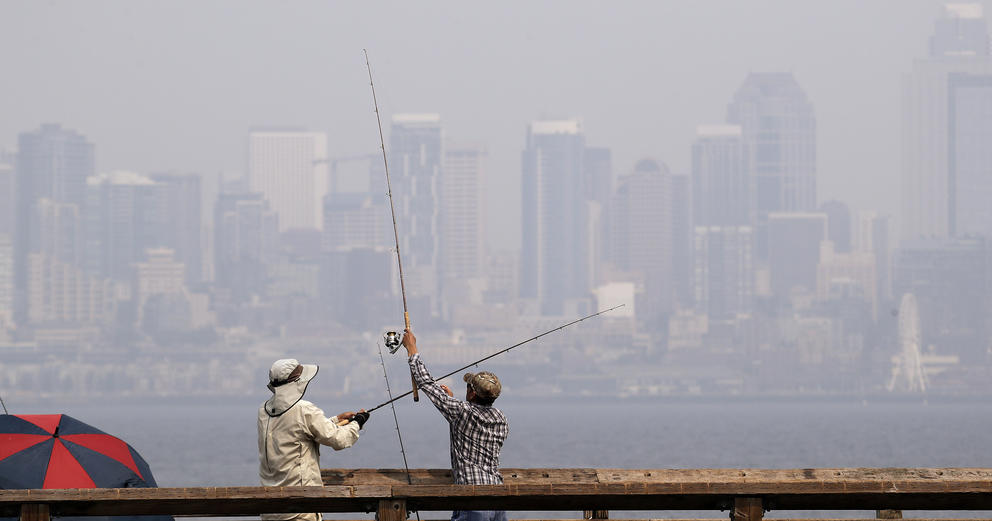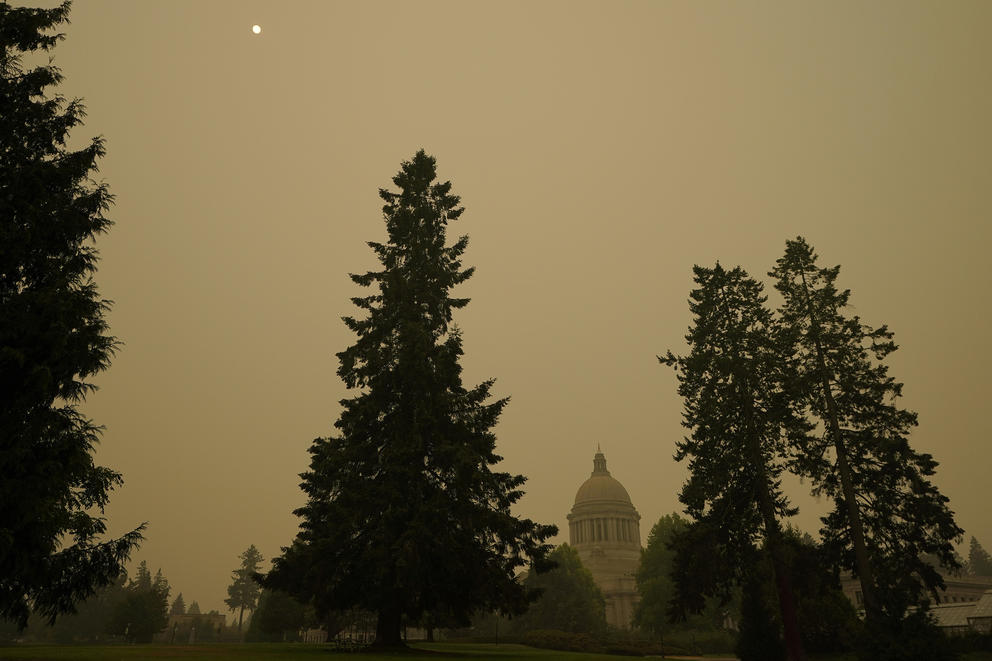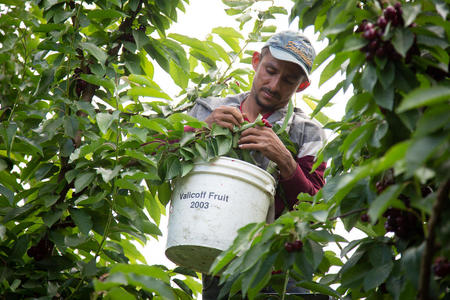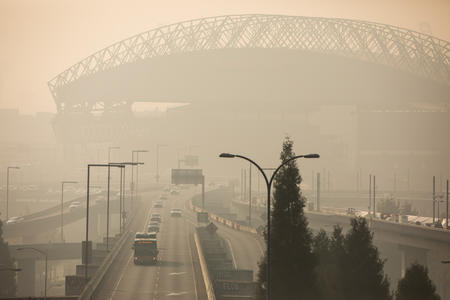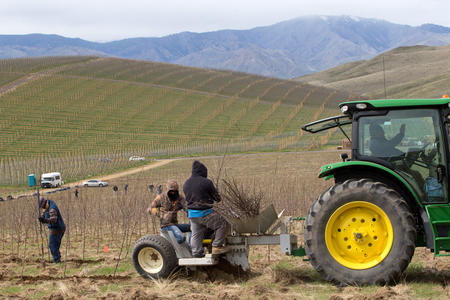“By the end of the day, when you get home and you blow your nose, you’ve got black stuff in your nostrils, a few bloody noses, you’re coughing all the time because of the smoke,” said Lal, a member of Laborers’ Local Union 242, which represents workers in the building trades in King County. “It just sucks.”
While Lal said his current employer has always made him feel comfortable enough to take breaks and adjust his pace when he feels fatigued, not everyone is so lucky.
As climate change worsens the number and intensity of wildfires, people everywhere face the short- and long-term health effects of smoke exposure, from shortness of breath, to headaches and even death. Those who work long hours outside, like Lal, are increasingly at the mercy of their employers to minimize their exposure.
There are no federal regulations explicitly protecting outdoor workers from wildfire smoke. But in the next few months, Washington could be the second state to impose a permanent rule regulating outdoor workers’ exposure to one of the fastest-growing pollutants.
Two summers after the state Department of Labor & Industries implemented an emergency seasonal rule, it’s now collecting public comment on a proposed permanent rule that would regulate industries where people tend to work outside: construction, agriculture and even public transit. Noticeably exempted are wildland firefighters, who take the brunt of frontline smoke.
This story is part of Crosscut’s WA Workplace Watch, an investigative project covering worker safety and labor in Washington state.
The permanent language has taken years to develop, with affected industries challenging ambiguities in the language, questioning the rule’s scientific basis and claiming new regulations would halt work. Meanwhile, those advocating on behalf of farmworkers fear the rules do not go far enough to protect them, as each summer brings simultaneous concerns over heat and smoke protections.
But the stakes are high: L&I officials said the compounding nature of the threat has made the rule a priority, and there is no emergency rule currently in effect after the previous version expired last fall.
“Given the increasing frequency [of smoke] ... we had a duty to act,” said Dr. Nicholas Reul, a physician with L&I.
Tracking harmful smoke levels
As people breathe, they can inhale tiny particulates deep into their lungs. Some of the smallest and most damaging of these particulates measure just 2.5 microns in diameter or less — many times smaller than even the width of a human hair. In the past, traffic and industrial emissions produced most of the Particulate Matter 2.5 (PM 2.5) in the U.S., but now wildfire smoke makes up a significant share of pollution and triggers air-quality alerts in every season.
When we see air quality alerts, we’re often not looking at the actual concentration of PM2.5 in the air. Rather, we’re looking at the Environmental Protection Agency’s Air Quality Index, which rates the seriousness of pollution on a scale from zero (healthy) to 500 (extremely hazardous and beyond which the EPA considers a health emergency).
Washingtonians are increasingly exposed to moderate or worse PM2.5 air pollution. A 2021 joint study by NPR’s California Newsroom and Stanford University found that state residents experienced more than twice as many smoky days between 2016 and 2020 as they did between 2009 and 2014. In the summer of 2022 there were seven workdays that would have required employers of outdoor workers to have respirators available under the new rule.
L&I will require employers to monitor daily forecasts and hourly estimates for PM 2.5 or the equivalent AQI.
Employers must track forecasts for their work locations either through websites and phone applications from several approved government agencies; by reaching out to those agencies directly; or by installing an air monitor of their own on site. Government forecasts pull pollution data from a series of official monitors across the state, and can send forecasts from the closest available monitors to a specific ZIP code.
In this Sept. 12, 2020, file photo, smoke from wildfires in Oregon and California create hazy skies as the sun is seen above the Washington state Capitol in Olympia. After multiple seasons of hazardous smoke, Washington is developing permanent rules that will require employers to protect their workers from the growing source of air pollution. (AP Photo/Ted S. Warren)
L&I’s new proposed rules require employers to make sure they are prepared to react to a poor AQI reading before smoke rolls in on their workers. This means putting together a smoke response plan: figuring out how they’ll communicate with workers, train employees to report smoke and coordinate medical treatment for employees who say they’re experiencing symptoms like shortness of breath, nausea, chest pain and dizziness. They need to inform their employees of their right to medical care without retribution.
As soon as the AQI hits 69, employers need to notify their workers about the air quality; pull employees from the field if they have not received wildfire smoke training; and “consider” reducing worker exposure to smoke through means such as moving them to a different site, adding rest periods and offering free respirators.
The proposed regulations ramp up alongside the AQI from there.
When the AQI hits 101 — the threshold of being unhealthy for sensitive groups — L&I would require employers to have an N95 respirator available for any employee who might want one, and to start physically reducing workers’ exposure to smoke. Washington’s Department of Health considers outdoor workers a demographic sensitive to smoke. The same rules apply for amounts of smoke the EPA deems “unhealthy for everyone,” and even “very unhealthy” — an amount that can cause serious health effects even in otherwise healthy people.
During fire season, the AQI can go much higher. When it hits 301 — a smoke level considered a hazardous condition for everyone — L&I would require employers to move any employees suffering from self-reported smoke symptoms to a location with clean air and actively hand out respirators to all employees. When it’s smoky out, it’s also often hot out, and wearing a respirator can make people more susceptible to heat-related illness.
The proposed L&I rules would still allow for continued work when the AQI is literally off the charts — the EPA stops counting after 500 AQI. At this point employers have to make sure their employees’ respirators fit their faces — which can involve the contentious request of recommending employees shave. (Respirators fit best on clean-shaven faces, but the CDC made waves when it released an illustrated guide to mask-friendly facial hair styles.)
“It does matter to a lot of folks,” L&I’s Ryan Allen said. “It was a point of contention for labor.”
Rewriting the rules
It took multiple years and thousands of line edits for the draft rule to get to this point, Reul said, and some significant rule adjustments have happened in that period.
L&I’s proposed permanent rule would require employers to keep respirators on hand for employee use at lower levels of pollution than were specified in the expired emergency rules. The agency is also requiring employees to wear respirators above a much higher pollution threshold than originally considered, and exempting employees who spend only small amounts of time outside.
In a preliminary analysis, L&I estimated the rule as written will cost employers collectively $10.7 million to $14.6 million annually — justified by the estimate that the rule will create between $17.6 million and $27.8 million in annual benefits, “in addition to other significant but unquantifiable benefits.”
“Our rule has been designed to make sure that businesses can continue to stay open and work and that employees are protected even at high concentrations,” said Reul, who consulted throughout the drafting process with Oregon and California agencies implementing smoke rules in those states.
While some businesses will shut down before the air becomes hazardous, Reul said some workers, like emergency responders and utility technicians, may have to continue to work when it’s dangerous.
Under what conditions must a person work on smoky days? “That’s up to employers to decide,” Reul said.
Employer and employee advocates alike say they are supportive of safer work environments, but worry that ambiguities in the rule leave room for, respectively, too much or too little employer responsibility.
Jan Himebaugh of the Building Industry Association of Washington, which represents home builders and remodelers, said the proposed rules are concerning to her membership.
“Like most things, there’s sort of a rational place to land on this, and I think L&I decided to take the most cautious approach,” she said. “There’s just a lot of ambiguity, and we know what happens when ambiguity happens. My members don’t know how to comply and they get fined.”
The proposed rules leave a lot up to the employer to decide, and L&I’s enforcement is often complaint-based. L&I does sometimes conduct program inspections at work sites in high-hazard industries, and if a compliance officer comes across potential violations, Allen said, “it would be up to that compliance officer to determine what’s appropriate abatement and how they’re going to go through the citation process.”
The proposed rules require employers to monitor the AQI, and to rely on the monitor in the state’s network closest to their worksite. Some worksites might be relatively far from a monitor, but L&I isn’t requiring employers to purchase their own monitors.
Employers are not required to file their smoke response and respiratory protection program documents with the state before starting work, but would be expected to have them if a compliance officer showed up.
Employers are responsible for training their employees about smoke safety, health impacts, and their rights to report symptoms. L&I provides online resources for what needs to be included in this training, but employers are responsible for providing the training.
Local 242 representatives said the draft language is protective enough, but there are concerns about whether employers can rely on two different measures of air quality to make decisions: either the AQI, or the more conservative WAQA, which people worry might leave some sites open while others close at the same location.
Farmworkers raise concerns
Farmworker advocates have collectively voiced apprehension on a myriad of issues – from making respirators mandatory at 500 AQI to concerns about accessibility and enforcement on the government’s behalf.
“I think the thing that’s missing is political will – to follow on all the recommendations that the science is providing,” said Edgar Franks, political director for Burlington-based farmworker union Familias Unidas por la Justicia. His organization has been pushing for mandatory masking and for starting protections at 50 AQI – which Franks ultimately sees as a “big, big ask” from the state, as prior experiences with L&I’s permanent heat-protection rulemaking convinced him the state was simply willing to “go off of what [the] emergency rule has been in the past” rather than respond to any drastic changes.
Mayra Reiter, project director for occupational safety and health at Farmworker Justice, expressed similar concerns, telling Crosscut that their partners across Washington have previously alleged that employers had not informed workers of evacuation orders and that workers had generally struggled with receiving emergency information in other languages such as Spanish.
“These are all things that make these situations especially dangerous for people who are working outside,” she said, “and the enforcement of this or any other rule really needs to be taken seriously.”
One of Farmworker Justice’s partners is the Quincy Community Health Center, which has offered wildfire protection training when, they say, employers did not. The organization reached out to various growers across Central Washington to test a curriculum it had drafted with the Pacific Northwest Agriculture Safety and Health Center at the University of Washington with cultural competence and accessibility in mind.
Mary Jo Ybarra-Vega, the outreach coordinator who spearheaded these efforts, said this curriculum was created in response to the COVID-19 pandemic but expanded once her organization began hearing increasing concern from farmworkers over compounding heat- and smoke-related complications.
Recently the Quincy Community Health Center has sent promotores de salud, lay health workers from Spanish-speaking communities, to fields to monitor the conditions of farmworkers as both temperatures and air quality worsen.
“They’re like community health workers, but specifically have that specialized training, that specialized relationship that English-speaking community health owners don’t have to have – that relationship and that trust,” Ybarra-Vega explained. “I think that’s one of the things that the growers are really understanding – that our organization, our promotores de salud, have that so they can just come right in there and establish relationships and trust and get the work done.”
Imelda Mariscal, a promotora de salud who works alongside Ybarra-Vega, has made it a priority this summer to distribute N95 masks among farmworkers, and said workers often appreciate the extra protection.
“It’s just that they don’t have [N95 masks] or they don’t want to buy them because it’s coming out of their pocket,” she said, “but when I provide them masks, they are thankful.”
Continued public comment
In the public comment on previous drafts, industry representatives raised concern about everything from respirators impairing worker health during high heat to whether it’s reasonable to expect employers to keep stocks of respirators.
John Gancel, WSDOT Safety Program Manager, questioned whether the rule’s scientific basis was sound. “The studies are generally looking at outcomes for wildfire smoke exposure for 24-hour periods or longer, and DOSH is proposing to regulate exposures beginning at 1 hour,” he wrote in a comment.
Even a few minutes of exposure to wildfire smoke can create health problems. Hazardous air can come on suddenly, and Washington’s rules require employers to have masks available at lower AQIs than California’s do.
Himebaugh argued that between rest accommodations in the new heat-protection rule and the draft smoke rule, “we’re sort of going to be at a standstill” in building housing.
Despite alleged pushback against respirator requirements at lower levels of AQI, University of Washington occupational health researcher Chris Zuidema said, “I’ve noticed a generally increasing recognition that wildfire smoke exposure is hazardous, and that people are acting to reduce their exposure … [and] I’m hopeful that where skepticism about wildfire smoke exposure in workplaces remains, a similar change in attitude occurs.”
People like John Lal who work in construction certainly aren’t strangers to masks. Many work applications already require respirators, and with COVID-19, Lal said, people are used to them and it’s not really that inconvenient to wear a mask. He used to wear masks frequently to avoid inhaling clouds of dust when he mixed concrete.
“Wearing a mask, it’s annoying. I’ve been doing it through COVID and all that stuff, but, it’s not a big deal,” he said. “At least to me. My co-workers, they’d rather do what’s going to be healthy for them in the long run.”
Billy Hetherington, political director for Laborers’ Local Union 242, has heard from some of the union’s roughly 7,000 members — who work in and manage employees across commercial construction and the public sector — that everyone feels worse on the job during smoke. “I would definitely take the remarks by members out in the field actually enduring these types of events as fact.”
When it comes to the rule’s financial impact, Hetherington said union members overwhelmingly consider safety over costs, and says he thinks it will be good for employers’ insurance costs that they can show insurers that they carry personal protective equipment for their workers.
Elena Austin, a UW public health researcher who has presented at L&I stakeholder meetings, believes the rule is well-structured but anticipates some trouble with implementation. She worries whether rural employers, who may be far from official monitors, will have access to good-enough air-quality information, and sees a need for clarifying methods for assessing wildfire smoke exposure.
Also, “Employers will have to plan well in advance of wildfire season,” Austin said, “to procure and store the quantity of N95 filtering facepiece respirators necessary to comply with the regulation.”
She also noted that the differences in size among industries may affect how well employers are able to follow, and how well agencies are able to consult on and enforce regulations.
L&I is still accepting public comment until this Friday, Aug. 4.
The agency’s Ryan said the rule’s filing date will depend on the number of comments received. The more comments, the more time they’ll need. And they may encounter feedback that prompts changes to the rule.
“We do intend on having something adopted this fall,” he said.

